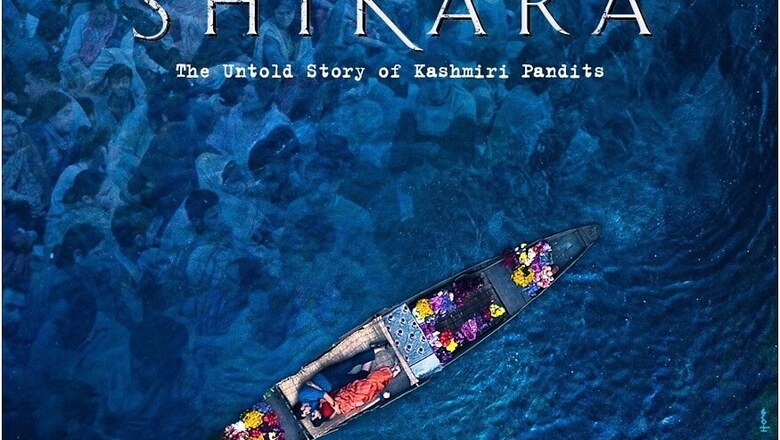
views
The hype around the movie Shikara is much ado about nothing. No doubt the movie is a gripping love story narrated masterfully by Vidhu Vinod Chopra. However, on the plight of Kashmiri Pandits, the movie is far below expectations. Actually, the exodus is a passing reference and contextualises the love story that begins and ends on the ‘shikara’.
Perhaps, the director realised that and changed the tagline from the ‘Untold Story of Kashmiri Pandits’ to ‘A Timeless Love Story in the Worst of Times’. The second tagline is more apt whereas the first is an appropriation of emotion of a community that is still looking for justice.
Chopra took Kashmiri Pandits who were victims of the exodus to various TV studios and tried to recreate what happened 30 years ago. It appeared that the director was genuinely interested in highlighting the plight of the community in exile. But when you see it in the context of the movie, you realise it was like rubbing salt on wounds.
Chopra used KPs to create the hype without reflecting their real concerns. The hype may draw people to the movie but they will get back still wondering how it happened and why it happened.
This also means that without this attempted touch of realism, the movie would have been a plain love story like many other films set in the background of Kashmir or Kashmiri culture.
The director sensed an opportunity to market the plight of a community without addressing the pressing concerns. Perhaps he thought after 30 years, the community would not react adversely as the anger must have subsided. It would rather be an eerie moment to revisit the past.
Any Kashmiri Pandit watching the movie would get a connect because the movie has tried to show Kashmiri culture, marriage rituals, music and dance, the bond between the couple, roganjosh etc. Those who stayed in refugee camps where there used to be walls of sarees would definitely be able to relive the moment of struggle, tears would roll down their eyes and they would feel pride that they have done well.
Thus far and no further. The movie does not take viewers anywhere. Shikara, which begins with romance on Dal Lake, ends in a shikara overlooking Taj Mahal because the protagonist’s wife wanted to see the Taj before she died.
One wonders how many Kashmiri Pandit brides would like to see the Taj. The Taj, as a cultural icon, does not figure in the dream of a Kashmiri Pandit girl although it may figure in the imagination of a Muslim girl.
To a Kashmiri Pandit bride, the cultural symbols she would associate with are Tulmul, Parbat or maybe the Nishat Garden.
The movie has shown the exodus which is easy because of the footage available but has failed to capture the context that led to the exodus.
It is here that the movie has failed completely. Any movie on KPs would fail unless it talks of radicalisation of the Muslim community there, genocide of Pandits, exodus, life in the camp, and success stories that have made the KPs proud.
A few incidents of violence because a politician gets killed at a protest and his son wants revenge from India and a massive exodus cannot be justified. Such a goonda can be dealt with easily.
The better reference book to capture those moments that led to the exodus would have been then Governor Jagmohan’s book ‘My Frozen Turbulence in Kashmir’. The film has failed to talk about Jihadis, mosques blaring anti-India slogans and asking Pandits to leave. One would be baffled not to see the silent majority protest unless motivated by the lure to capture the house.
Chopra has put the blame on the government at the Centre for imposing its own politics. People would like to watch why major players were silent when such an exodus happened. What was the role of the Abdullahs and the Muftis?
The exodus was not because a few youths took up arms, but because the entire Islamic society had become radicalised. It has not shown Pandits as flag-bearers of Indian nationalism in Kashmir and the insults they were subjected to; how Pandits wished that India would lose the cricket match so they would not be subjected to the torture of becoming the target. Read any book on the plight of Pandits and you will get many such stories.
A better research would have given the complete picture. But secularism would not allow to call a spade a spade.
Hundreds of books by Kashmiri Pandits have thousands of stories. That the genocide aspect has been completely left out shows that the film was never an ‘Untold Story of Kashmiri Pandits’ as claimed by the filmmaker.
Many communities have lived the life of a refugee. The Pandits were special as they were hounded out because of their faith. They were seen as India’s link to the Valley. So you have created a refugee of the proud community without stating the reasons.
India should not sympathise with them but fight for their justice — the emotion the film fails to evoke. The film fails to evoke anger at such a massive fight which is said to be sixth in the history of the Pandits.
Pandits are shown being treated badly by some people when they register at refugee camps. This is depicted as if they were not welcome in India, which is not true. There may have been one or two individuals who may have reacted adversely or failed to understand the magnitude of the tragedy, but the country as a whole was shocked and did not know how to react. We failed as a citizen and this feeling Chopra failed to evoke.
I would not have reacted to the movie until I realised after seeing the movie that it would be taken by gullible and secularists as the real depiction and confuse the issue for generations to come. Call it fiction and don’t claim this is untold story of Kashmiri Pandits.
(The author is a BJP spokesperson. Views expressed are personal.)




















Comments
0 comment